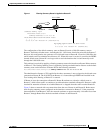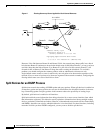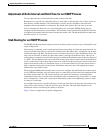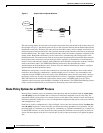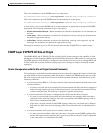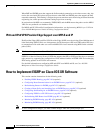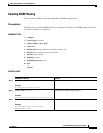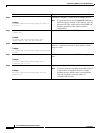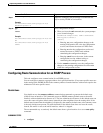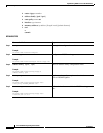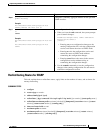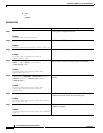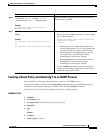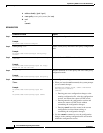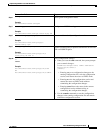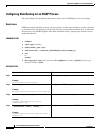
Implementing EIGRP on Cisco IOS XR Software
How to Implement EIGRP on Cisco IOS XR Software
RC-151
Cisco IOS XR Routing Configuration Guide
OL-14356-01
Configuring Route Summarization for an EIGRP Process
This task configures route summarization for an EIGRP process.
You can configure a summary aggregate address for a specified interface. If any more specific routes are
in the routing table, EIGRP advertises the summary address from the interface with a metric equal to the
minimum of all more specific routes.
Restrictions
You should not use the summary-address summarization command to generate the default route
(0.0.0.0) from an interface. This command creates an EIGRP summary default route to the null 0
interface with an administrative distance of 5. The low administrative distance of this default route can
cause this route to displace default routes learned from other neighbors from the routing table. If the
default route learned from the neighbors is displaced by the summary default route or the summary route
is the only default route present, all traffic destined for the default route does not leave the router;
instead, this traffic is sent to the null 0 interface, where it is dropped.
The recommended way to send only the default route from a given interface is to use a route-policy
command.
SUMMARY STEPS
1. configure
Step 9
bandwidth-percent percent
Example:
RP/0/RP0/CPU0:router(config-eigrp-af-if)#
bandwidth-percent 75
(Optional) Configures the percentage of bandwidth that
may be used by EIGRP on an interface.
Step 10
end
or
commit
Example:
RP/0/RP0/CPU0:router(config-eigrp-af-if)# end
or
RP/0/RP0/CPU0:router(config-eigrp-af-if)#
commit
Saves configuration changes.
• When you issue the end command, the system prompts
you to commit changes:
Uncommitted changes found, commit them before
exiting(yes/no/cancel)?
[cancel]:
–
Entering yes saves configuration changes to the
running configuration file, exits the configuration
session, and returns the router to EXEC mode.
–
Entering no exits the configuration session and
returns the router to EXEC mode without
committing the configuration changes.
–
Entering cancel leaves the router in the current
configuration session without exiting or
committing the configuration changes.
• Use the commit command to save the configuration
changes to the running configuration file and remain
within the configuration session.
Command or Action Purpose



